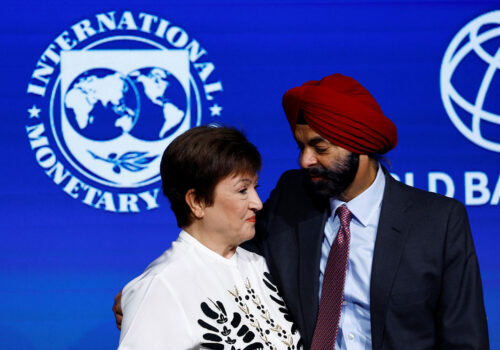Multilateralism under pressure: Takeaways from the 2025 IMF Spring Meetings
Widespread unease among finance ministers and central bank governors marked the annual spring meetings of the International Monetary Fund (IMF) and the World Bank. The Trump administration’s ambiguous posture toward the Bretton Woods institutions and possible US global retrenchment loomed especially large. Pierre-Olivier Gourinchas, the chief economist of the IMF warned that “We are entering a new era, as the global economic system that has governed the past eighty years is being reset” when he unveiled the latest World Economic Outlook. In the same address, the IMF revised its global growth projection for 2025 downward to 2.8 percent—a sobering signal of the mounting costs of economic fragmentation. Unsurprisingly, uncertainty emerged as the defining motif of the meetings.
In her traditional Global Policy Agenda speech, the IMF managing director, Kristalina Georgieva, sought to temper market anxieties and reassure member countries. She struck a tone of cautious optimism and underscored the Fund’s institutional preparedness while candidly acknowledging a range of serious global risks. She outlined three interlocking priorities to frame the week’s deliberations: (1) resolving trade tensions and restoring confidence, (2) safeguarding economic and financial stability, and (3) reviving medium-term growth through structural reforms.
Acknowledging the gravity of the moment, Georgieva stated, “We’re not in Kansas anymore,” a metaphor underscoring the unfamiliar and turbulent terrain the global economy now faces. She advocated for a comprehensive and coordinated settlement among major economies aimed at rolling back trade barriers, reducing policy uncertainty, and restoring the openness of global trade flows. She warned that prolonged ambiguity was already suppressing investment and eroding consumer confidence.
In this context, the IMF reiterated its longstanding position that both tariff and non-tariff barriers must be lowered to preserve multilateralism. However, the challenge extends beyond immediate trade disputes. Structural imbalances—including China’s elevated savings and weak domestic consumption, the United States’ sustained fiscal deficits, and the European Union’s incomplete economic integration—are increasingly viewed as drivers of systemic strain. To correct these asymmetries, the IMF recommended: (1) stimulating domestic demand in China, (2) advancing infrastructure investment and market integration in Europe, and (3) embarking on credible fiscal consolidation in the United States. The IMF portrayed these national adjustments as preconditions for global macroeconomic rebalancing and long-term resilience.
The second thematic pillar—economic and financial stability—highlighted the narrowing margin for error after years of policy stimulus in response to the pandemic, inflationary shocks, and geopolitical disruptions. Georgieva’s appeal to “get your house in order” captured the moment’s urgency. She urged countries to reinforce their fiscal foundations by implementing credible and transparent medium-term frameworks.
While she broadly encouraged gradual deficit reduction, Georgieva gave particular attention to low-income and emerging economies, which are confronting acute debt vulnerabilities amid tightening global financial conditions. For these nations, the policy agenda emphasized enhanced domestic revenue mobilization, improved public financial management, and proactive engagement with debt restructuring mechanisms. On the monetary front, Georgieva advised central banks to remain guided by incoming data and preserve their operational independence, while continuing to focus on price stability. The meetings also addressed mounting concerns over the stability of the financial system, including the risks posed by non-bank financial intermediaries, and called for more robust regulatory oversight and international coordination.
Finally, the IMF’s managing director placed renewed emphasis on the structural transformation needed to revive medium-term growth. As Georgieva declared, “Now is the time for long needed but often delayed reforms.” With global potential growth trending downward, she plainly acknowledged the limitations of monetary and fiscal policy.
Instead, discussions centered on national reform agendas tailored to each country’s specific institutional context. These included measures to improve the business climate, enhance governance and the rule of law, modernize labor and product markets, and strengthen innovation ecosystems and digital capacity. For emerging and developing economies, the imperative to expand access to finance, invest in human capital, and build sustainable infrastructure was seen as crucial to catalyzing private sector participation. Climate resilience and inclusive growth were integrated into the broader reform discourse, reflecting the growing consensus that sustainability must be embedded in long-term economic strategy. The IMF committed to supporting member countries in these efforts through targeted instruments—such as the Resilience and Sustainability Trust—alongside bespoke policy advice and capacity development.
A pivotal intervention during the meetings came from US Secretary of the Treasury Scott Bessent, who addressed the Institute of International Finance with a call for the IMF to return to its original mandate. He criticized the Fund’s perceived “mission creep” into areas such as climate, gender, and inequality. He acknowledged these issues as important, but potentially distracting from the IMF’s core objectives of macroeconomic stability, balance of payments support, and monetary cooperation. Bessent reaffirmed US support for the Fund and the World Bank, while clarifying that continued engagement would hinge on institutional discipline, rigorous program conditionality, and a sharper focus on correcting global imbalances. His remarks signaled not just a recalibration of US expectations, but a broader ideological debate over the role of multilateral financial institutions in a fragmenting global order.
Georgieva’s response the following day was diplomatically calibrated. In an April 24 press briefing, she welcomed continued US engagement and described Bessent’s comments as constructive. “The United States is our largest shareholder… of course, we greatly value the voice of the United States,” she remarked, interpreting the speech as a reaffirmation of US commitment at a time when political rhetoric had raised fears of disengagement. She acknowledged the legitimacy of US concerns and noted that ongoing institutional reviews—including the Comprehensive Surveillance Review and the Review of Program Design and Conditionality—would serve as venues for deeper discussions. These mechanisms, she suggested, provide space to reexamine priorities, refine programs, and ensure alignment between the Fund and its major stakeholders.
But what do US concerns about the IMF’s direction truly entail, and how might they be addressed in the upcoming policy reviews? It is crucial to recognize that, despite holding over 16 percent of the Fund’s voting power, the United States cannot unilaterally block the IMF executive board’s approval of the regular Comprehensive Surveillance Review. This implies that the most consequential negotiations will, as is customary, occur informally and behind closed doors. We can anticipate that the US executive director’s office will try to shape a draft document that aligns with Washington’s preferences.
However, the United States is not the only influential voice at the table. Other member states—many of whom have divergent priorities, particularly on issues such as climate integration, social inclusion, and the future scope of macroeconomic surveillance—will also seek to assert their positions. The previous surveillance review in May 2021 introduced climate macro-criticality into Article IV consultations for the twenty largest greenhouse gas emitters. Whether the United States can successfully build a broad coalition to revise the surveillance framework in line with its renewed emphasis on “core” macroeconomic fundamentals remains to be seen.
Yet despite the Spring Meetings attendees’ efforts to project cohesion and forward momentum, the underlying global outlook remains clouded by persistent uncertainty. Geopolitical tensions, rising debt burdens, and diverging monetary policy trajectories continue to weigh on policy coordination platformed by the IMF.
As attention shifts toward the 2025 annual meetings this October, critical questions will come into sharper focus. Can the IMF meaningfully recalibrate its surveillance priorities? Will members find the political will to realign quotas and governance structures? How will the Fund balance its evolving role with the demands for institutional discipline? These meetings will not merely be another milestone in the global economic calendar—they may well constitute a stress test for the resilience of the postwar international system and its ability to adapt in an increasingly complex, multipolar world.
Bart Piasecki is an assistant director at the Atlantic Council’s GeoEconomics Center.
The views and opinions expressed herein are those of the author and do not reflect or represent those of the US government or any organization with which the author is or has been affiliated.
Related content

At the intersection of economics, finance, and foreign policy, the GeoEconomics Center is a translation hub with the goal of helping shape a better global economic future.
Image: Washington D.C., USA - January 12, 2020: Sign of The International Monetary Fund (IMF) on their headquarters building in Washington D.C. IMF is an international organization.



